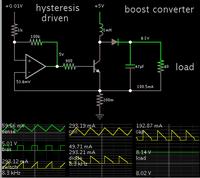GeoAVR
Member level 2
Hi all,
I have a question regarding the feedback network of an boost converter.
All power electronics books derive equations for the Vout of converters as a function of duty cycle.
But without a feedback controller these equations never hold true and they almost never describe how to build a feedback controller.
Is there a methodology for feedback design?
If i take the error = Vreference - Vout how to I create a Duty cycle?
Furthermore, in the simplest case of a P controller, how do I deside for the GAIN of the controller.
Thank you
I have a question regarding the feedback network of an boost converter.
All power electronics books derive equations for the Vout of converters as a function of duty cycle.
But without a feedback controller these equations never hold true and they almost never describe how to build a feedback controller.
Is there a methodology for feedback design?
If i take the error = Vreference - Vout how to I create a Duty cycle?
Furthermore, in the simplest case of a P controller, how do I deside for the GAIN of the controller.
Thank you
